
The common tapeti, also known as the Brazilian cottontail, forest cottontail, or (formerly) simply tapeti is a species of cottontail rabbit. It is small to medium-sized with a small, dark tail, short hind feet, and short ears. As traditionally defined, its range extends from southern Mexico to northern Argentina, but this includes several distinctive population that have since been split into separate species. Under this narrower definition, the true common tapeti only occurs in the Atlantic Rainforest of coastal northeastern Brazil and it is classified as "Endangered" by the IUCN. The American Society of Mammalogists concurs, but also tentatively classifies several distinct populations that have not yet received proper species names into S. brasiliensis, and thus considers it to range from Venezuela south to Argentina.

Enyo lugubris, the mournful sphinx, is a moth of the family Sphingidae. It is found from Argentina and Paraguay to Uruguay, Venezuela, Guyana, Suriname, French Guiana, Colombia, Ecuador, Peru, Brazil and the West Indies through Belize, Guatemala, Honduras, El Salvador, Nicaragua, Costa Rica and Panama to Mexico and the United States, where it has been recorded from Arizona east to Florida and north to South Carolina. Strays have been recorded from Arkansas, north to Illinois, Michigan and New York.

Aegiphila is a genus of flowering plants in the mint family, Lamiaceae, first described in 1763. It was formerly classified in the Verbenaceae. It is native to Mexico, Central America, South America, the West Indies, and Florida.

Mechanitis polymnia, the orange-spotted tiger clearwing or disturbed tigerwing, is a butterfly of the family Nymphalidae. It is found from Mexico to the Amazon rainforest. The wingspan is 65–75 mm (2.6–3.0 in). The larvae feed on Solanum species.

Anthanassa frisia, the Cuban crescentspot, Cuban checkerspot or Cuban crescent, is a butterfly of the family Nymphalidae. Subspecies tulcis is known by the common names pale-banded crescent or Tulcis crescent; it is treated as a species by some authors.

Archonias is a monotypic genus of butterflies in the family Pieridae. Archonias brassolis, the cattleheart white, is its sole species. It is found from Central America, south through most of South America.
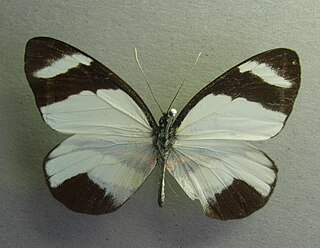
Perrhybris pamela, the Pamela, is a butterfly of the family Pieridae. It is found from Mexico, Honduras, El Salvador, Costa Rica and Panama, south to Colombia, Venezuela, Suriname, French Guiana, Brazil, Ecuador, Peru, and Bolivia. This species breeds in lowland rainforest at altitudes between sea level and about 900 metres.

Castniomera is a monotypic moth genus in the family Castniidae described by Constant Vincent Houlbert in 1918. Its single species, Castniomera atymnius, commonly known as the giant butterfly-moth, was first described by Johan Wilhelm Dalman in 1824. It is known from Mexico through Central America to Venezuela.

Marpesia is a butterfly genus in the family Nymphalidae. The species of this genus are found in the Neotropical and Nearctic realms.

Prepona laertes, the shaded-blue leafwing or Laertes prepona, is a butterfly of the family Nymphalidae. It is found in large parts of Central and South America.

Itaballia pandosia, the Pisonis mimic or brown-bordered white, is a butterfly in the family Pieridae. It is found in the Amazonian regions of Brazil, Ecuador, Peru, and in Central America, Colombia and Venezuela. The habitat consists of primary rainforests. It may be a mimic of Moschoneura pinthous
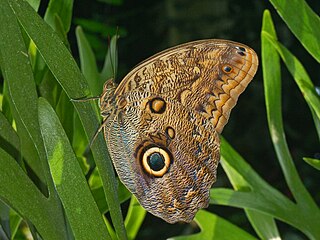
Caligo illioneus, the Illioneus giant owl, is an owl butterfly belonging to the nymphalid family, Morphinae subfamily, tribe Brassolini.
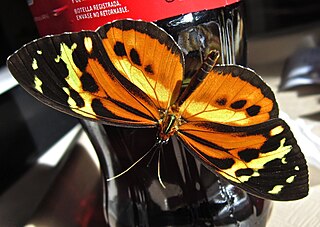
Tithorea harmonia, the Harmonia tiger-wing or Harmonia tiger, is a species of butterfly belonging to the family Nymphalidae.
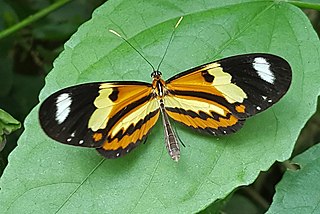
Mechanitis lysimnia, the confused tigerwing, sweet-oil tiger or lysimnia tigerwing, is a species of butterfly of the family Nymphalidae. It was described by Johan Christian Fabricius in 1793. It is found in Central and South America, from southern Mexico to Uruguay. The habitat consists of disturbed forests at altitudes up to 1,500 metres (4,900 ft).
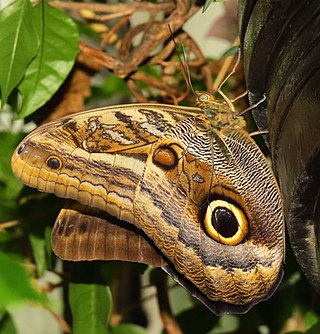
Caligo oileus, the Oileus giant owl, is a butterfly of the family Nymphalidae.

Caligo teucer, the Teucer owl butterfly is a butterfly of the family Nymphalidae. It was described by Carl Linnaeus his 1758 10th edition of Systema Naturae. It is found from Colombia and Venezuela to Bolivia and Paraguay. The habitat consists of rainforests and cloudforests at altitudes ranging from 400 to 1,400 meters.
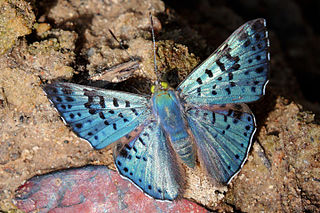
Lasaia agesilas, the glittering sapphire, black-patch bluemark or Narses metalmark is a metalmark butterfly. The species was first described by Pierre André Latreille in 1809. It is native to Central America and the north of South America. It ranges from Costa Rica, Panama, Venezuela, Trinidad, Colombia, Ecuador, Peru, Bolivia, Guyana, Argentina, to the Brazilian Amazon.
This is a list of the Honduras national football team results from 2000 to 2009.

"Calephelis" is a genus of butterflies that belongs to the family Riodinidae. They are resident in the Americas. There are 43 species in the Neotropical regions and 11 species in the Nearctic.


















